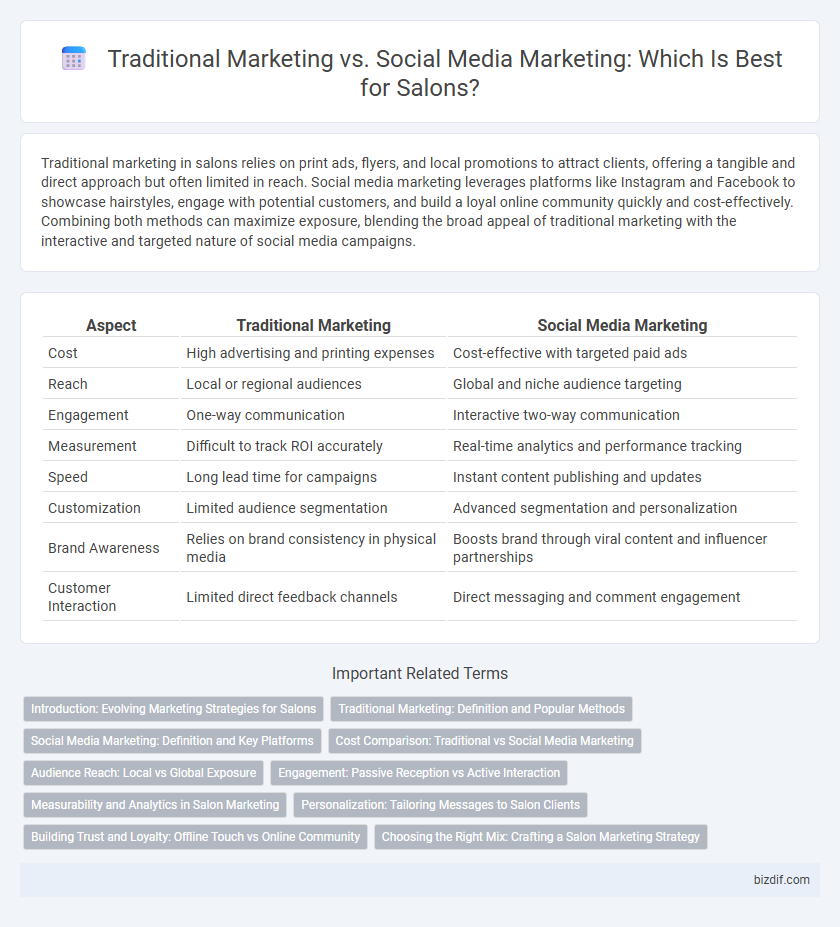Traditional marketing in salons relies on print ads, flyers, and local promotions to attract clients, offering a tangible and direct approach but often limited in reach. Social media marketing leverages platforms like Instagram and Facebook to showcase hairstyles, engage with potential customers, and build a loyal online community quickly and cost-effectively. Combining both methods can maximize exposure, blending the broad appeal of traditional marketing with the interactive and targeted nature of social media campaigns.
Table of Comparison
| Aspect | Traditional Marketing | Social Media Marketing |
|---|---|---|
| Cost | High advertising and printing expenses | Cost-effective with targeted paid ads |
| Reach | Local or regional audiences | Global and niche audience targeting |
| Engagement | One-way communication | Interactive two-way communication |
| Measurement | Difficult to track ROI accurately | Real-time analytics and performance tracking |
| Speed | Long lead time for campaigns | Instant content publishing and updates |
| Customization | Limited audience segmentation | Advanced segmentation and personalization |
| Brand Awareness | Relies on brand consistency in physical media | Boosts brand through viral content and influencer partnerships |
| Customer Interaction | Limited direct feedback channels | Direct messaging and comment engagement |
Introduction: Evolving Marketing Strategies for Salons
Traditional marketing for salons relies on local advertising methods such as flyers, print ads, and word-of-mouth referrals to attract nearby clients. Social media marketing leverages platforms like Instagram and Facebook to showcase hairstyles, engage with a broader audience, and drive online bookings. The shift toward digital campaigns enables salons to track client interactions and tailor promotions based on real-time analytics, enhancing customer acquisition and retention.
Traditional Marketing: Definition and Popular Methods
Traditional marketing in salons involves offline strategies such as print advertisements, flyers, direct mail, billboards, and local event sponsorships to attract and retain clients. These methods emphasize personal interaction and brand presence within a community, leveraging established media channels for customer engagement. Popular traditional marketing techniques include distributing salon brochures, offering referral discounts, and advertising in local newspapers or magazines to build trust and visibility.
Social Media Marketing: Definition and Key Platforms
Social media marketing leverages platforms like Instagram, Facebook, and TikTok to engage salon clients through targeted ads, influencer partnerships, and interactive content. These platforms enable salons to showcase hairstyles, promotions, and customer testimonials, driving higher visibility and booking rates. Compared to traditional marketing, social media offers real-time analytics and personalized engagement, enhancing client retention and brand loyalty.
Cost Comparison: Traditional vs Social Media Marketing
Traditional marketing methods for salons, such as print ads, flyers, and local radio, often incur higher upfront costs and ongoing expenses compared to social media marketing. Social media platforms offer cost-effective options like targeted ads and organic content promotion, allowing salons to reach a broader audience with a smaller budget. Analytical tools on platforms like Instagram and Facebook enable precise tracking and optimization, increasing marketing ROI compared to traditional methods.
Audience Reach: Local vs Global Exposure
Traditional marketing in salons primarily targets a local audience through channels like print ads, flyers, and community events, ensuring deep engagement within a specific geographic area. Social media marketing expands reach globally by leveraging platforms such as Instagram, Facebook, and TikTok, allowing salons to connect with a diverse international audience and attract clients worldwide. The shift from local exposure to global engagement enhances brand visibility and opens opportunities for broader customer acquisition and online reputation building.
Engagement: Passive Reception vs Active Interaction
Traditional marketing in salons often relies on passive reception, where clients receive information through flyers, print ads, or in-store promotions without immediate feedback mechanisms. Social media marketing enhances engagement by fostering active interaction through comments, shares, and real-time conversations on platforms like Instagram and Facebook, increasing client loyalty and brand visibility. This dynamic interaction allows salons to respond quickly to customer preferences, creating personalized experiences that traditional methods cannot match.
Measurability and Analytics in Salon Marketing
Traditional marketing in salons relies on qualitative feedback and indirect metrics, making it challenging to measure campaign effectiveness precisely. Social media marketing offers detailed analytics, such as engagement rates, click-throughs, and audience demographics, enabling salon owners to assess return on investment and tailor strategies in real time. Platforms like Instagram and Facebook provide comprehensive insights, allowing salons to optimize promotions and target specific customer segments efficiently.
Personalization: Tailoring Messages to Salon Clients
Traditional marketing in salons relies on generalized messages such as flyers and local ads, which often lack personalization and can miss the unique preferences of individual clients. Social media marketing enables salons to tailor content through targeted ads, personalized messages, and interactive engagement based on client behaviors and preferences. This personalized approach boosts client retention and enhances the overall customer experience by addressing specific needs and interests directly.
Building Trust and Loyalty: Offline Touch vs Online Community
Traditional marketing leverages face-to-face interactions and tactile experiences, fostering trust through personal connections and consistent service quality in salons. Social media marketing builds loyalty by creating interactive online communities where clients engage through reviews, tutorials, and real-time communication, enhancing brand transparency and client rapport. Combining offline touchpoints with dynamic digital engagement maximizes client retention and deepens emotional connections to the salon brand.
Choosing the Right Mix: Crafting a Salon Marketing Strategy
Selecting the ideal marketing strategy for a salon involves balancing traditional marketing methods, such as print ads and local events, with dynamic social media marketing tactics including Instagram promotions and influencer collaborations. Leveraging data analytics from social media platforms enables targeted campaigns that enhance client engagement and retention, while traditional marketing sustains community presence. A tailored blend based on customer demographics and market trends optimizes brand visibility and drives consistent salon growth.
Traditional Marketing vs Social Media Marketing Infographic

 bizdif.com
bizdif.com